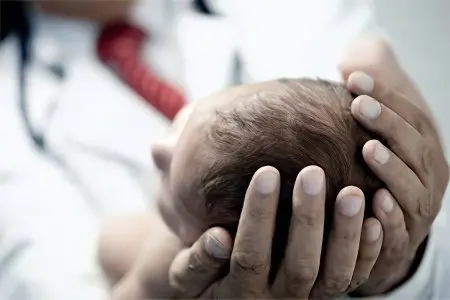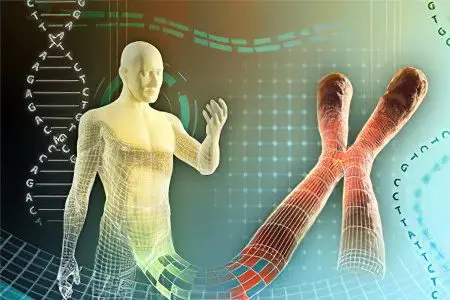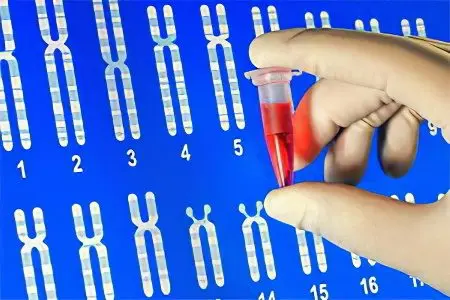Contents
Patau syndrome is one of the longest discovered and studied chromosomal diseases. Back in 1657, the symptoms of this disease were described by Erasmus Bartholin, although it was only by 1960 that Dr. Klaus Patau, after whom he got his name, proved that it was provoked by a genetic defect. Interestingly, frequent cases of Patau syndrome were observed among the inhabitants of the tribes from the Pacific Islands, which gave reason to consider the main cause of the disease to be the radiation spread in that area as a result of field tests of atomic bombs.
Normally, a human chromosome set contains 44 homologous (paired) and two sex chromosomes. For various reasons, in very rare cases, errors are possible during the divergence of chromosomes during cell division of the embryo, due to which aneuploidy occurs – a change in the karyotype. The case when an extra chromosome is synthesized is defined as a trisomy.
In fact, Patau syndrome is a pathological condition of the human genome, in which an extra thirteenth chromosome is detected. In this regard, the disease has received the scientific name trisomy 13. The frequency of this pathology reaches 1:7000, but usually this figure fluctuates around 1:10000-1:14000. The sex ratio of patients with trisomy 13 is approximately 1:1. A characteristic sign of newborns with this disease is true prenatal hypoplasia in 25-30%, which manifests itself at a normal gestational age (without slight prematurity).
The structure of trisomy 13 consists of a variety of developmental defects:

Central nervous system – microcephaly, holoprosencephaly (defects of the hemispheres at the stage of formation), meningomyelocele of the spinal cord, deficiencies in motor and mental development;
Peripheral nervous system and sensory organs – microphthalmia, cataracts, deformity of the auricles;
Musculoskeletal system and skin – extra fingers, umbilical hernia (omphalocele), splitting of the upper (cleft lip) and palate (up to the cleft palate), protruding heel, absence of skin or hair (most often eyebrows);
Hearts – congenital heart disease (ventricular septal defect);
Genitourinary organs – pathologies of the kidneys and abnormal development of the genital organs.
To reliably determine the presence of Patau syndrome before the birth of a child, prenatal screening is performed, and after birth, a karyotype analysis is done.
Genetic details
Basically, there are two genetic forms of trisomy on the thirteenth chromosome:
Simple trisomy – three chromosomes of the same species freely exist and realize their genetic potential.
Robertsonian translocation – two chromosomes remain free, and the third merges with long arms with another acrocentric chromosome (for example, with 14 or 21). Since acrocentric chromosomes in short arms have only rRNA genes that are repeatedly duplicated in the karyotype, their functionality is retained in most cases.
In any case, the karyotype of a patient with Patau syndrome is determined by the formula 47 XX (XY) 13+. Sometimes cases of non-Robertsonian translocations, isochromosomal and mosaic forms of trisomy 13 are recorded.
The pathological picture and symptoms in the genetic varieties of Patau’s syndrome do not differ. In 3/4 of patients, an extra 13 chromosome is found, the remaining quarter of patients suffer from the involvement of 13 pairs of chromosomes in translocation, which in 75% of cases is due to a mutation again (new, self-generated) – the so-called “genetic error”. Patau syndrome inheritance studies show that the remaining 25% of trisomy 13 cases are due to the transmission of a translocalized thirteenth chromosome from one of the parents. At the same time, the risk of a recurrence of the case in the next child (return risk) is 14%.
Symptoms of Patau Syndrome
Patau syndrome has many characteristic features that appear before and after the birth of a child:
In half of the cases, such a complication of pregnancy as polyhydramnios is recorded – an excess of the amount of amniotic fluid in the amniotic cavity, characteristic of a certain period of pregnancy. It is determined by the amniotic fluid index, calculated during an ultrasound examination of the fetus.
Newborn babies with trisomy 13 have an underweight of about 2,5 kg.
Defects indicating insufficient formation of the cardiovascular system: atrial or interventricular septal defect, vascular transposition, one umbilical artery, are present in 80% of patients.
The widest list of defects is recorded on the part of the musculoskeletal system and the musculoskeletal system: a sloping and low forehead, narrowing of the eye sockets and a decrease in the distance between them, retraction of the bridge of the nose, expansion of the nose at the base, deformation of the auricles, cleft lip, splitting of the palate, cleft palate , extra fingers and toes, shortened neck, umbilical hernial formations.
Ophthalmic pathologies are also common: corneal opacity, congenital coloboma (splitting of the lens, retina, optic nerve, choroid, crystal, or eyelid), which occurs due to improper closure of the slit of the eye cup, microphthalmia (congenital reduction of the eyeball).
In some organs of the digestive system, severe pathological processes occur: fibrocystic formations in the pancreas, the development of extra spleens.
From the genitourinary system, the genitals and kidneys suffer. The size of the kidneys exceeds the norm, cysts form in their cortical tissue, and the bodies of the organs have an excessively strong division into lobes. The genitals are abnormally enlarged or deformed.
Severe mental and motor retardation is characteristic of all surviving children with complete Patau syndrome – their condition is characterized as idiocy. This is accompanied by such pathologies of the development of the central nervous system as microcephaly (underdevelopment of the brain) and holoprosencephaly (impaired formation of the cerebral hemispheres).
In some cases, some of the symptoms of Patau syndrome coincide with other congenital malformations characteristic of a number of diseases, for example, Mohr and Meckel syndromes or Opitz trigonocephaly. In order to correctly, accurately and reliably determine the disease, it is necessary to study the karyotype. Even if the pregnancy is terminated surgically or the child died in a short time, it is imperative to carry out a cytogenetic diagnosis of a chromosomal disease, which is necessary to warn parents about the danger and determine its likelihood.
Causes of Patau Syndrome

The main cause of all the above destructive features of insufficient fetal development is the third thirteenth chromosome. It is assumed that, being an extra copy, it makes it difficult for cells to read the genome, which interferes with the normal formation of tissues and the timely completion of their growth and development.
Studies of the exact reasons for the nondisjunction of the thirteenth chromosome in meiosis have not been carried out, since this requires the organization of large-scale data collection in all cases and comparison with various data on the putative factors affecting the genome. The situation is also complicated by the fact that it is not known for certain when exactly the aforementioned failure occurs – at the stage of formation of germ cells or during the formation of a zygote. Simpler analyzes of the history data allowed scientists to conclude that the chance of developing trisomy 13 increased with maternal age, although this relationship is less significant than the proven dependence of the occurrence of Down syndrome.
It is assumed that Patau’s syndrome can be triggered by ionized radiation, infectious diseases, the influence of various toxicants, the unfavorable ecological state of the environment, and even bad habits.
Many scientists argue that the above-described mutation of the sex or germ cell occurs by chance, like many other mutations. againto which every person is exposed. It follows from this that Patau’s syndrome is a natural deviation for each species, which, with a negligible probability, can happen to any person.
This can be said about complete trisomy 13, but the form of the disease with a balanced translocation is hereditary. It can occur in a child with a low probability, or it can be inherited without a manifestation of the syndrome, since the “third-extra” chromosome 13 in this case is associated with another chromosome and is dangerous only for the next generation.
Diagnosis of Patau’s syndrome
To confirm or refute the suspicion of trisomy 13, as in the case of other genetic diseases of the embryo (Edwards syndrome, Down syndrome, etc.), it is necessary to undergo screening.
Diagnosis begins with an ultrasound examination and analysis of special biochemical markers, which allow you to roughly calculate the risk of the disease in the child of the woman being examined.
According to the results of the first stage, the expectant mother can be attributed to the risk group.
In this case, prenatal diagnosis is carried out by invasive methods:
At 8-12 weeks – a biopsy of the chorionic villi;
At 14-18 weeks – amniocentesis;
After the twentieth week – cordocentesis.
The samples obtained from the biological materials of the fetus are subjected to operations to search for trisomy of the thirteenth chromosome using karyotype analysis by differential staining of chromosomes or PCR diagnostics.
If the specialist did not find on ultrasound the reasons for additional examinations, and prenatal diagnosis was not carried out, the neonatologist can determine the genetic abnormality in the infant due to clinical symptoms and dermatographic changes. However, only the analysis of the karyotype can be the basis for confirming the diagnosis of trisomy on the thirteenth chromosome.
Treatment of Patau syndrome

It is impossible to correct chromosomal abnormalities. The complex work of a group of various specialists is to constantly monitor the patient’s health and support the family. At the moment, medicine does not have means that can affect the body at the genetic level, and chromosomal abnormalities in Patau syndrome affect most cells.
In general, the prognosis for people with Patau syndrome is disappointing – less than 15% survive to the age of five, and in countries with a high level of health care systems, 2-3% of patients survive to the age of ten. At the same time, children need constant care, and even in the absence of fatal organ damage, they suffer from mental disability and will never be able to adapt socially and take care of themselves on their own.
There is no chance of recovery, the only thing that can be done for the patient is to improve his living conditions, correct his condition and comorbidities. Children with this disease should be constantly examined by a pediatrician, neurologist, ophthalmologist, geneticist, otolaryngologist and other specialists. Surgical intervention for the correction of pathologies of the heart, kidneys and abdominal organs is performed according to the indications of a general surgeon.
Thus, maintaining the viability of a patient with Patau syndrome is impossible without the participation of several specialists and their interaction, since chromosomal abnormalities can affect different organs and systems and disrupt their work.









